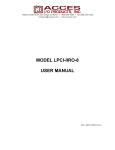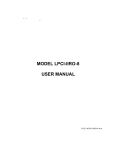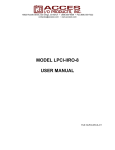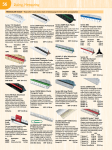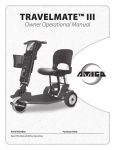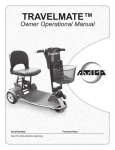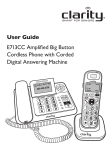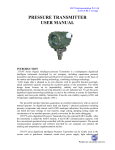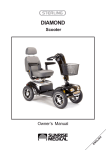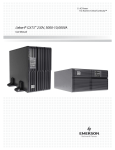Download Amigo Classic Owner`s Manual
Transcript
OWNER’S & O P E R AT I N G MANUAL Re a d T h i s M a n u a l Before Operating Serial Number: Purchase Date: TABLE OF CONTENTS Safety First 3-4 Location of Controls Identification of Parts 4 4 Assembling Your Amigo 5 Adjusting Your Amigo Operating Your Amigo 6 7 Riding Your Amigo Safety Warnings 7-8 8 Battery Information & Charging Instructions 9-10 Cleaning Instructions Maintenance 10 11-12 A new industry began in 1968 when Amigo revolutionized mobility for people with walking limitations. Amigo Power Operated Vehicles (POVs) quickly became a household name for their ease of operation and maneuverability. Ever since our first creation, Amigo Company has worked hard to bring comfort, freedom and satisfaction to our many thousands of customers. In 1977, the United States Social Security Act was amended to include the Amigo Power Operated Vehicle as an official medical mobility device, creating new opportunities for accessibility by Medicare clients across the nation. Worldwide, more people than ever are discovering the Amigo lifestyle. We would like to take this opportunity to thank you for choosing Amigo. Our business will provide you with personalized and innovative electric mobility products and customer satisfaction, today and in the future. Sincerely, Amigo Mobility International, Inc. (AMI) Troubleshooting 13 Electromagnetic Interference 14 Wiring Diagram 15 Welcome to the Amigo family of active and independent Exploded View 16 people. For thousands of individuals around the world, Parts List 17 Amigo provides the opportunity to enjoy life more fully. Warranty 18 We are confident that the following instructions and helpful hints will make your Amigo an extremely useful and reliable “friend.” Because we are concerned about your health and safety, please read this manual carefully before operating your vehicle. After learning to use your Amigo properly, you will discover a world of enjoyment and independence. Please return your warranty card to be placed on our mailing list for Friendly Wheels. Friendly Wheels is a publication about owners participating in life. It also keeps you informed about new products, accessories, helpful hints and service tips! Wishing you happiness and good health from all of us at Amigo Company Amigo Mobility International, Inc. (AMI) disclaims any responsibility for personal injury or property damage resulting from the improper or unsafe use of its products. 2 SAFETY FIRST For your convenience and understanding, signal words are defined below: WARNING IS USED TO INDICATE THE PRESENCE OF A HAZARD, WHICH CAN CAUSE SEVERE PERSONAL INJURY, DEATH OR SUBSTANTIAL PROPERTY DAMAGE IF THE WARNING IS IGNORED. CAUTION IS USED TO INDICATE THE PRESENCE OF A HAZARD WHICH WILL OR CAN CAUSE MINOR PERSONAL INJURY OR PROPERTY DAMAGE IF THE WARNING IS IGNORED. Safety Suggestions Use the following guidelines for the safe operation and use of your Amigo. Should you have any questions about the safe operation of your vehicle, please contact AMI or your Amigo Dealer. If you are in doubt about your ability to operate your Amigo, consult your personal physician. DO • Read the operating manual before using your Amigo. • Always turn your Amigo OFF before getting on or off your vehicle. • When transferring off your Amigo, do make sure the Seat Lock is in the locked position. • Always remain seated while the vehicle is in operation. • Keep legs on the platform while driving. • Allow the Amigo to come to a complete stop before attempting to reverse. • Always drive at a slow, sensible manner while pedestrians are around. • Drive slowly while turning and on inclines. • Always drive straight up and down inclines. • Always be careful when maneuvering on inclines or ramps. Not all ramps are constructed according to Federal standards. The Federal standard for wheelchair ramps is one-inch (2.5 cm) rise per foot (30 cm). • Do avoid sudden starts while the handle is turned sharply. • Always approach obstacles at a low speed if you are to drive over them. • Be aware of mechanical pinch points, especially when assembling and disassembling your Amigo. • Always remove Battery Pack when loading or disassembling your Amigo. TURNING THE SWITCH OFF WHILE IN MOTION WILL BRING THE AMIGO TO AN ABRUPT STOP. DO NOT • Do not exceed the maximum weight capacity. Exceeding the weight capacity voids your warranty and may result in personal injury and damage to your Amigo. Amigo Company will not be responsible for injuries and/or property damage resulting from failure to observe weight limitations. • Do not drive over or off obstacles more than 1 inch (2.5 cm) high. This could be unsafe and could damage your Amigo. • Do not turn your Amigo at high speeds, as this could result in tipping. • Do not reverse down a steep hill or incline. • Do not park on inclines or declines. • Do not sit on the Amigo in a moving vehicle. • Do not allow anyone to ride with you. 3 • Do not operate your Amigo near stairs, steps, curbs or terraces where you might accidentally drop a wheel off the edge. • Do not operate your Amigo on streets or other areas with vehicular traffic. • Do not disengage your brake lever when parked on a slope. • Do not leave the brake lever engaged while driving. • Do not use the handle to assist in transferring. • Do not lift rear section of platform by holding the rear wheel. • Do not expose your Amigo to spray-on cleaning solutions and excessive moisture such as spraying it with a garden hose, shower or leaving it uncovered in heavy rain. AMI is not responsible for any damage or injury incurred due to the improper or unsafe use of the POV. AMI specifically disclaims responsibility for any bodily injury or property damage that may occur during any use, which does not comply with applicable federal, state or local laws or ordinances. LOCATION OF CONTROLS HI/LO Speed Adjustment Handle 1 Accelerator Lever (Right and Left) 2 ON/OFF Switch 3 Battery Indicator Light 4 Forward and Reverse Position Diagrams for Accelerator Levers 2 1 4 3 IDENTIFICATION OF PARTS 1 Battery Case (detachable) 2 Tiller and Drive Head (detachable) 3 Front Drive Wheel 4 Rear Wheels 5 Platform 6 Seat 7 Charger 8 Take Apart Knob 9 Optional Travel Pouch (removable) 7 8 9 10 10 Handle Adjustment Lever 11 Brake Lever 6 12 Battery Power Connector 13 Folding Seat Latch 14 Battery Case Latch 11 2 12 1 5 2 3 4 4 13 14 ASSEMBLING YOUR AMIGO To Assemble the Take Apart Version: 1 Place the Seat in the Seat Post and lock the Seat Lock Lever. 2 Tip Amigo backwards, so it is resting on the Seat back. 3 Lift the Front Assembly (Tiller and Drive Head) up and align the two posts on the Rear Platform with the two holes on the Front Assembly (Tiller and Drive Head), keeping both surfaces flush. 4 Turn Take Apart Knob clockwise until tightened (approximately 8 turns). 5 Tip Amigo upright, so it is resting on its wheels. 6 Replace Battery Pack and connect Battery Connector. Seat Installation 1 Unlock the Seat Lock. 2 Insert the Upper Seat Post into the opening of the Lower Seat Post. 3 Spin Seat around to make sure it rotates freely. 4 To lock the Seat, pull the Seat Lock Lever toward the rear of the Seat. Battery Pack Installation 1 Set the Battery Case on the Battery Case Hanging Bracket. 2 Center the Battery Case with Handle and swing it into the Handle, ensuring that the Velcro engages at the bottom of the Battery Case. The Latch on the top of the Battery Case will engage itself. 3 Connect the Battery Power Connector to the Battery Case by aligning the Connector. ENSURE THE LATCH AND VELCRO ARE FULLY ENGAGED TO AVOID THE BATTERY CASE DISLODGING DURING OPERATION OR TRANSPORTING. ENSURE THAT THE BATTERY POWER CONNECTOR IS CONNECTED TO THE BATTERY CASE SECURELY DURING OPERATION. WHILE CHARGING ENSURE THAT THE BATTERY CHARGER CONNECTOR IS ATTACHED SECURELY TO THE BATTERY CASE. To Disassemble and Transport your Amigo by taking apart the Front Assembly: 1 Turn Amigo OFF. 2 Unplug Battery Connector and remove Battery Pack. 3 Tip Amigo backward, so it is resting on the Seat back.. 4 Turn Take Apart Knob counterclockwise (approximately 8 turns), and lift Front Assembly (Tiller and Drive Head) off Frame. 5 Tip Amigo upright, so it is resting on its wheels. 6 Unlock and remove Seat. 7 Lift Rear Platform into trunk of vehicle. Place parts in trunk. DO NOT LIFT THE AMIGO CLASSIC TILLER BY THE BATTERY CASE HANDLE. 5 ADJUSTING YOUR AMIGO To adjust your Amigo to a comfortable driving position, you can alter the Handle, Seat and Armrests as follows: EZ-Tilt Handle Adjustment To adjust the angle of the Handle, turn the Adjustment Lever counterclockwise. Move the Handle to the desired position. Tighten the Adjustment Lever by turning it clockwise (Figure 1). The placement of the spring-activated Adjustment Lever, itself, can be moved out of the way for your comfort. Pull the Adjustment Lever straight out. Turn in either direction. Release Adjustment Lever at desired placement (Figure 2). Figure 1 DO NOT USE THE HANDLE ADJUSTMENT LEVER FOR A FOOT REST. SUCH USE MAY CAUSE THE ADJUSTMENT LEVER TO LOOSEN THE HANDLE AND CAUSE PERSONAL INJURY. Figure 2 Adjusting Seat Height To raise or lower your seat height, remove the nut and screw that holds the Seat Collar in place on the Seat Post, then adjust and reinstall in the desired hole on the Seat Post. (Figure 3) It is recommended that the Seat Lock be installed in the second hole position from the seat on a Folding Seat and the Premier I Seat. (Figure 4) Seat Lock Lever Figure 3 This allows the Seat to rotate 360 degrees and lock in any position desired. The Seat Lock Lever is a bar with a vinyl cap on its end, located under the right side of the Seat. Push the Lever forward to rotate to any position. Adjustable Armrest Width (Premier I Seat Only) The Armrest width is determined by loosening the Armrest Knobs and tightening them when the arms are at the desired width. Flip Up Armrest (Premier I Seat Only) By pulling up on the end of either Armrest, the Armrest will flip back for easy transfer in and out of the Amigo. 6 Figure 4 OPERATING YOUR AMIGO To operate your Amigo, use the following procedures: • Turn on your Amigo with the ON/OFF switch located on the right side of the Handle Control. • Pull the Forward Accelerator Lever or the Reverse Accelerator Lever to move the Amigo. To move forward, pull the right side of the Accelerator Lever toward you (Figure 5). You can also move forward by pushing the left side of the Accelerator Lever away from you. To operate in reverse, pull the left side of the Accelerator Lever toward you or push the right side of the Accelerator Lever away from you. • Speed is controlled by how far the Accelerator Lever is pulled. Figure 5 • To stop, just release the Accelerator Lever and the vehicle will come to a gradual stop within a few seconds after release. RIDING YOUR AMIGO For your first sessions, be sure you are on a level surface. Stand behind the seat and reach down to the Seat Lock Lever. It is located on the right side directly under the seat. Grasp the end of the Lever and push forward, releasing the seat. It will now turn easily to meet you. When seat is positioned for transfer, engage Lever to the Locked position to steady the seat before you sit down. When seated, release the Seat Lock and turn forward to driving position. When positioned, re-engage Lever to the Locked position, if desired. Turn the power ON. Pull the Right Accelerator Lever to start off in a Forward motion. To stop, simply let go. Basic Driving Make sure you are properly seated. Turn the power ON by operating the ON/OFF Switch. On handle, pull the Accelerator Lever as described earlier. You will gently accelerate. The further you pull the Accelerator Lever, the faster you will go. Release the Lever and you will gently stop. Please note that Reverse speed is slower than Forward speed. Practice these two basic functions until you get used to them. Steering the Amigo is easy and logical. Just be sure to remember to give wide clearance when turning so that the rear wheels clear any obstacle. Shortcutting a sidewalk corner can cause the back wheel to go off the sidewalk, causing problems if the corner is very rough. Avoid this at all times by steering an exaggerated wide arc around the obstacle. If you must steer in a tight spot, such as entering a doorway or when turning around, stop and then apply power gently. For more on maneuvering through obstacles, see the next section. Driving Through Doorways Approach an unfamiliar door slowly. Does it have a knob or push bar? Does it open toward or away? Think in terms of using the power of the Amigo to do the work for you. Hold the doorknob or bar in one hand and apply the power with the other hand. If it is a self-closing door, you can go through allowing the door to close behind you. If it is not a self-closing door, just stop when you are clear of the door and push it closed. If the door opens toward you, hold the knob or bar with one hand and gently press on your reverse thumb lever and allow the gentle reverse power to do the work. When the door is open wide enough, pull the Forward Accelerator Lever moving forward, leaving your hand on the door to keep it free of the Amigo and letting go as you pass the door jamb. 7 Driving On Ramps With the ADA (Americans with Disabilities Act), buildings require ramps for POV (Powered Operated Vehicle) access. Some have U-turns in the middle where good cornering is required. Take wide swings with your front wheels around any tight corners so the rear wheels follow a wide arc to stay clear of the corner. When you have stopped while facing uphill, starting up again simply requires that you apply forward power. Accelerate gently after stopping on an incline. When proceeding up a ramp or curb, lean forward in your seat for maximum stability and safety. Going down any ramp or hill, drive slowly to ensure a safe descent. Transport Amigos are not designed or tested for use as seats for users in private or public transporting vehicles. AMI advises against transporting POVs in vehicles unless either the unit is dismantled and placed in the trunk of your car, or the assembled unit is placed in the vehicle and strapped down. Any straps should be secured to non-removable parts of the unit, i.e. Platform. Even when strapped down, Amigos should not be used as seats in private or public transporting vehicles. To transport your Amigo: 1 Turn Amigo OFF. 2 Unlock and remove Seat. 3 Unplug Battery Connector and remove Battery Pack. 4 Fold Handle down to Platform by loosening Handle Adjustment Lever. 5 Place parts in trunk. DO NOT LIFT THE AMIGO CLASSIC TILLER BY THE BATTERY CASE HANDLE. Airline Travel “Special Handling” tags are suggested when transporting your Amigo by the Airlines. Nonspillable, sealed batteries are approved for travel on airplanes. When you make your reservation, notify the airline that you will be requesting “escort”service. This will assure that your Amigo will be picked up and delivered at the boarding gate. For additional Helpful Hints for Airline Travel, visit our website at www.myamigo.com. Public Transportation Some public transportation systems have accommodations for your Amigo, but you must transfer to a seat. When utilizing public transportation, do not sit on your Amigo while it is being lifted onto the vehicle, or once the vehicle is in motion. SAFETY WARNINGS The driving performance of your Amigo can be influenced by electromagnetic fields, such as emitted by cellular telephones and other emitting devices. We recommend the power on your unit be switched off when using such a device. (refer to Electromagnetic Interference section for additional information) • In some extreme circumstances, your Amigo’s performance could be affected by the electromagnetic field emitted from alarm systems in shops. (refer to Electromagnetic Interference section for additional information) • The Program Settings in the Controller should not be altered as this may give unsafe driving characteristics. 8 BATTERY INFORMATION AND CHARGING INSTRUCTIONS Battery Information For maximum range and life, it is recommended to fully charge the batteries before using. Extended charging is good for the batteries and will not overcharge them. Amigos have an overcharge protection feature so that the batteries can be charged anytime the Amigo is not being used. It is a popular misconception that batteries should be deeply discharged before recharging. This is not the proper procedure for all batteries. They can actually be damaged if they are discharged too deeply before recharging. Battery range depends on driver weight, terrain and type of battery used. Charge your batteries daily when the Amigo is used. Make sure that the Charger Cord is unplugged from the wall outlet before moving your Amigo. Batteries should be charged, if the Battery Indicator Light is blinking while operating. Your Battery Indicator Light may blink prematurely when under a heavy power demand such as an incline. If it is premature, it will stop blinking when the unit is stopped, and the power switch is cycled to OFF and back ON. If this cycle does not stop the blinking, it is time to recharge. Charging Instructions Disconnect the Battery Power Connector from the Battery Case. Plug the small DC Battery Charge Connector to the Socket on the Battery Case. Plug the AC Cord into the Wall Outlet. The charge cycle status is indicated by the Battery Indicator Light (LED) on the Charger. The LED will glow ORANGE to indicate charging has started. The Batteries are fully charged when the LED switches to GREEN. The Battery Charger is designed to accept 90-240 volts AC power input. This makes it possible to charge on any AC electrical system globally. Charging Frequency • Charge batteries daily when the Amigo is used. • If not in use for a long period of time, charge for 24 hours, every 30 days. • Extended charging is good for the batteries and will not overcharge them. Charger Standard Precautions • Refer to these instructions frequently. • Each time you use your charger, read and follow instructions exactly. Working in the vicinity of a battery is dangerous. Batteries generate explosive gases during normal battery operation. • Never smoke or allow an open flame in the vicinity of the battery. • Use charger for charging a Lead Acid Battery only. It is not intended to supply power to an extra-low-voltage electrical system or to charge dry cell batteries. • Do not operate charger in a closed-in area or restrict ventilation in any way. • A spark near the battery may cause explosion. To reduce risk of spark: • Prevent external damage to AC and DC cords. • When connecting charger, connect DC charging cord to the battery charge plug before connecting Charger AC cord to electrical outlet. • When disconnecting charger, always do so in reverse sequence of connecting procedure. Break first connection as far away from battery as possible. • Be extra cautious not to drop a metal tool onto the battery(ies). • Remove jewelry. 9 FAILURE TO FOLLOW THESE SAFETY INSTRUCTIONS MAY RESULT IN PERSONAL INJURY OR PROPERTY DAMAGE. IF YOUR BATTERIES ARE DAMAGED AND A LEAK IS APPARENT, CALL YOUR AUTHORIZED DEALER IMMEDIATELY. UNDER NO CIRCUMSTANCES SHOULD YOU TOUCH THE BATTERIES IF THEY ARE LEAKING. Battery Storage If you remove your batteries from the Battery Case, put them on a surface that cannot be damaged by acid fumes. Whenever a battery is charged and discharged through a cycle, it breathes. The breathing of the battery emits acid fumes and may mark surfaces it rests on for long periods of time. Store batteries indoors in a dry environment, away from any open flames. Temperature range is 0˚C (32˚F) to 40˚C (104˚F). TO AVOID DAMAGE TO BATTERIES DURING STORAGE, DO NOT PLACE THEM END-TO-END WITH THE POSITIVE (+) AND NEGATIVE (-) TERMINALS NEXT TO EACH OTHER (FIGURE 6). Figure 6 CLEANING INSTRUCTIONS Tires: The Tires should be cleaned with ordinary kitchen-type cleaners and a damp cloth. Don’t use solvents on Tires as they cause tire material to break down or become too soft. Platform: The Platform of the Amigo is constructed of steel and coated with a durable automotive type finish. Use cool water with mild soap to remove dirt and oils. Do not spray the entire vehicle with water. This will damage the electrical parts. The Platform may be waxed with car body wax and buffed by hand with a soft cloth. Seat: The Vinyl Seat can be cleaned with a mild soap or detergent and a damp cloth. A vinyl cleaner can also be used. Care should be taken not to soak Seats, as the interior foam rubber will hold water. Floor Mat: The Floor Mat should be cleaned with ordinary kitchen-type cleaners and a damp cloth. Do not use solvents on the Floor Mat, as they may cause the Floor Mat material to break down. KEEP CLEANING SOLVENTS AWAY FROM ELECTRICAL WIRES AND CONNECTIONS. 10 MAINTENANCE Minimum maintenance should prevent unnecessary repairs. You will get years of dependable operation if you follow the suggested maintenance schedule. Check the following: Daily Charge Batteries daily when the Amigo is used. Charge the Battery until fully charged to ensure proper Battery operation. Extended charging is good for the Batteries and will not overcharge them. Monthly Check and clean Battery Terminals and the Wire Connections as needed with a light piece of emery cloth or brush and soda water. • Clean Upholstery, Plastic and Metal with a mild surface cleaner. • Inspect Batteries for any cracks or damage of any kind. • Check and tighten any exposed Fasteners. KEEP CLEANING SOLVENTS AWAY FROM ELECTRICAL WIRES AND CONNECTIONS. Six Months • Check all Screws and Clips (that are holding wheels) for tightness and wear. • Check all Electrical Connections for clean contact. • Charging Connection should be inspected for tight Connection. • Check Tires for wear. • Inspect Seat Posts for wear. • Lubricate Plastic Bearings on Upper Seat Post. • Inspect inside the Battery Case, particularly at the bottom, for liquid. • Inspect Front Drive Belt for wear, tighten if needed. Yearly • Have your Authorized Service Center check your Amigo completely. • Grease Front Drive Chain. • Lubricate Steering Column Bearings. Battery Maintenance VRLA (Valve Regulated Lead Acid) Deep Cycle Batteries are used for operating your Amigo. They are maintenance-free and are transportable on aircraft, buses, trains, etc. as there is no danger of spillage. By following the Charger and Battery procedures, you can expect extended battery life. Fasteners Replacement Use only Grade 8 (US) or 12.9 DIN (metric) in all applications. For service and replacement parts, we recommend Amigo authorized parts. Microprocessor Controller (MPC) Do not attempt to service the MPC or related electronic components, as this will void the warranty. 11 Fuse Replacement Instructions A Fuse protects the wiring and battery in the event of a short circuit. If your Amigo stops abruptly, check the Fuse. If it has “blown,” check for overloads or short circuits. The Fuse is located on the Battery Case. To replace the Fuse: • Remove the Fuse from its Socket. Inspect for continuity (“blown”) • If blown, replace with the same style and size (Automotive style 20 AMP) Battery Replacement NOTE: Replacement Battery must meet passenger and cargo aircraft travel requirements. • Remove four Screws as shown and remove Battery Front Cover. • Remove the Black Wire from each Battery. • Lift each Battery far enough to expose the Red Wire Connection and remove it from each Battery. • Reverse this sequence to install Batteries. NOTE: Tampering with electrical or mechanical parts will invalidate your warranty. 12 TROUBLESHOOTING The Amigo is equipped with an ASIC Controller. This Controller has a Built-In Diagnostic Feature that will cause the Battery Indicator Light (LED) to flash a numeric code to indicate when there is a service problem. Under normal operating conditions the Battery Indicator LED will flash to indicate three different situations. 1. To indicate a low battery condition when driving. 2. To indicate the battery charging cycle has started. 3. To indicate when the batteries are fully charged during the charging cycle. When indicating a service problem, the Battery Indicator Light will flash, hesitate for a moment, and then flash again. Follow the code listings below to determine the problem. If the code indicates a service problem, contact your Authorized Dealer or call the Amigo Service Department at (800) 248-9131 for instructions to verify and correct the problem. Code Description Possible Solution 1-1 EM Brake windings Or connections are Shorted (1) Unplug unit and plug back in (2) Check all wiring connections and output (3) Disconnect brake and cycle key, if code changes to 1-2, replace brake (4) Replace controller 1-2 EM Brake windings or connections are open (1) Unplug unit and plug back in (2) Check all wiring connections and output (3) Replace brake (4) Replace controller Motor windings or connections are shorted (1) Check motor wiring and connections (2) Check running light (shorts) (3) Disconnect brake and cycle key, if code changes to 2-2, replace motor (4) Replace controller Motor windings or connections are open (1) Ensure EM brake lever is in drive position (2) Check motor wiring and connections (3) Replace motor (4) Replace controller Power relay short (1) Check / Replace batteries (2) Check / Replace controller PSL Motor short (1) Unplug handle cable and plug back in (2) Check PSL wiring and connections (3) Disconnect motor and cycle key, if code goes away, replace motor (4) Check / Replace controller Over temperature condition (1) Allow unit to sit idle for 15 minutes, restart and see if code disappears (2) Ensure EM brake and/or motor is not causing excessive amperage draw (3) Replace controller 4-1 Charger is supplying too much voltage during the battery charge cycle (1) Replace battery charger if voltage is 32 volts or higher (2) If 31volts or lower, replace controller 4-2 Charger not dropping back into “float mode” during battery charging cycle (1) Replace charger wiring (2) Replace battery charger (3) Replace controller Controller drive FETS shorted (1) Replace controller Controller regenerative braking FETS shorted (1) Replace controller 5-3 Throttle potentiometer or throttle circuitry reading fail band fault (1) Check to ensure handle cable is in good condition (2) Check that throttle lever moves freely and returns to center (3) Replace throttle potentiometer 5-4 Bad software revision (1) Replace controller 5-5 Controller not limiting the electrical current to the motor (1) Replace controller 2-1 2-2 2-3 2-4 3-1 5-1 5-2 13 ELECTROMAGNETIC INTERFERENCE RADIO WAVE SOURCES MAY AFFECT POWERED MOBILE VEHICLE CONTROL. Electromagnetic Interference (EMI) From Radio Wave Sources Powered vehicles may be susceptible to electromagnetic interference (EMI), which is interfering electromagnetic energy (EM) emitted from sources such as radio stations, TV stations, amateur radio (HAM) transmitters, two-way radios and cellular phones. The interference (from radio wave sources) can cause the powered vehicle to release its brakes, move by itself, or move in unintended directions. It can also permanently damage the powered vehicle’s control system. The intensity of the interfering EM energy can be measured in volts per meter (V/m). Each powered vehicle can resist EMI up to a certain intensity. This is called its “Immunity Level.” The higher the immunity level, the greater the protection. At this time, current technology is capable of achieving at least a 20 V/m immunity level, which would provide useful protection from the more common sources of radiated EMI. The immunity level of this powered vehicle is not known. There are a number of sources of relatively intense electromagnetic fields in the everyday environment. Some of these sources are obvious and easy to avoid. Others are not apparent and exposure is unavoidable. However, we believe that by following the warnings listed below, your risk to EMI will be minimized. The sources of radiated EMI can be broadly classified into three types: 1. Handheld portable transceivers (transmitters-receivers) with antenna mounted directly on the transmitting unit. Examples include: citizens band (CB) radios, “walkie talkie,” security, fire and police transceivers, cellular telephones and other personal communication devices. Note: Some cellular telephones and similar devices transmit signals while they are ON, even when not being used; 2. Medium-range mobile transceivers, such as those used in police cars, fire trucks, ambulances and taxis. These usually have the antenna mounted on the outside of the vehicle; and 3. Long-range transmitters and transceivers, such as commercial broadcast transmitters (radio and TV broadcast antenna towers) and amateur (HAM) radios. Note: Other types of handheld devices, such as cordless phones, laptop computers, AM/FM radios, TV sets, CD players and cassette players and small appliances such as electric shavers and hair dryers, so far as we know, are not likely to cause EMI problems to your powered vehicle. Powered Vehicle Electromagnetic Interference (EMI) Because EM energy rapidly becomes more intense as one moves closer to the transmitting antenna (source), the EM fields from handheld radio wave sources (transceivers) are of special concern. It is possible to unintentionally bring high levels of EM energy very close to the powered vehicle’s control system while using these devices. This can affect powered vehicle movement and braking. Therefore, the warnings listed below are recommended to prevent possible interference with the control system of the powered vehicle. Warnings Electromagnetic Interference (EMI) from sources such as radio stations, TV stations, amateur radio (HAM) transmitters, two-way radios and cellular phones, can affect electric vehicles. Following the warnings listed below should reduce the chance of unintended brake release or mobile vehicle movement, which could result in serious injury. 1. DO NOT operate or turn ON handheld personal communication devices, such as Citizens Band (CB) radios and cellular phones while the vehicle is turned on. 2. Be aware of nearby transmitters, such as radio or TV stations and try to avoid coming close to them. 3. If unintended movement or brake release occurs, turn the vehicle off as soon as it is safe. 4. Be aware that adding accessories or components or modifying the vehicle may make it more susceptible to interference from radio wave sources. Note: There is no easy way to evaluate their effect on the overall immunity of the vehicle. 5. Report all incidents of unintended movement or brake release to the mobile vehicle manufacturer, and note whether there is a source of EMI nearby. Important Information 14 1. 20 volts per meter (V/M) is a generally achievable and useful immunity level against EMI (as of May 1994). The higher the level, the greater the protection. 2. The immunity level of this product is not known. WIRING DIAGRAM 15 EXPLODED VIEW 16 PARTS LIST #800000 CLASSIC PARTS LIST- AMI0070505 TO PRESENT Part# Description 1035 Jackshaft bushing 1040 Qty/Unit Part# Description Qty/Unit 1 8675 Ground wire asm 1 Retainer snap ring 2 9357 Wheel housing blue 1 1069 Washer .65 ID .88 OD shim 4 9704 Charger 1.5 amp 24 volt 1 1132 Key woodruff 1 9751 Battery 7 AH w/ label 2 1184 Screw 1/4-20 x .50 truss 2 9936 Handle upper 1 1189 Washer .38 ID .75 OD cone lock 2 9950 Lever handle adjustment 1 1192 Washer .281 ID .63 OD .06 flat 10 10050 Bearing set 1 1253 Nut 5/16-18 hex 1 10144 Wire asm battery to controller 1 1270 Washer .39 ID .75 OD nylon 1 10200C Controller enclosure asm Classic 1 1271 Drive chain (68 link) 1 10341 Plug finish 1.62 ID 2 1272 Belt gear type 1 10391 Motor 24V DC 1 1344 Screw 1/4-20 x 1.50 hex 4 10402 Fork weldment 1 1450 Screw 5/16-18 x 2.50 hex 1 10534 Clamp nylon cable black 1 1872 Pulley driven 1 10586.21 Column asm blue EZ Tilt handle 1963 Wire loom .437 ID 2236 1 10” 10610 Grommet 7/8” groove dia. 5/8 ID 1 Screw 3/8-24 x 3.75 hex 1 10691 Wheel & sprocket asm 1 2237 Nut 3/8-24 hex 1 10766 Platform weldment Classic 1 2244 Jackshaft & sprocket (13 tooth) 1 10767 Battery case assembly Classic 1 2410 Cord AC 1 10772 Battery case bracket 1 2415 Pin .125 x .625 roll 3 10773 Mat Classic 1 3083 Nut 1/4-20 serrated flanged 6 10774 Spring brake lever 1 3536 Pulley motor 1 10775 Lever brake 1 3690 Label patent 1 10776 Bracket weldment brake shaft 1 4075 Screw 1/4-20 x 2.00 FHCS 2 10777 Spring take-apart lever 1 4790 Wheel 6” w/ bearing 2 10778 Pouch removable 1 5190 Screw 1/4-28 x .75 SHCS 1 10779 Lever platform take-apart 1 5560 Nut 3/8-16 hex nylon jam 1 10780 Seat Black value padded 1 6880 Boot lower seat post 1 10782 Seat post assembly upper Classic 1 7281 Screw 1/4-20 x .88 SHCS 2 7657 Screw #10-24 x .38 self tap 1 10785 10786 Wedge brake Cap brake lever 1 1 7834 Label AMI serial number 3 267000 Seat lock asm RH 1 7837 Label moving parts warning 1 267001 Stem collar with screw & nut 1 8458 Screw 1/4-20 x 1.50 button 4 300265 Seat post lower (includes fasteners) 1 17 WARRANTY Amigo® Brand Product Warranty (effective June 1, 2004). Amigo Mobility International, Inc. (AMI) warranties the original completed unit it manufactures to the original purchaser. 1 Structural components including platform, frame and seat post, have a lifetime warranty against defects in materials and workmanship. 2 Transaxle, motor, controller and battery charger, are warranted against defects in materials and workmanship for two (2) years. 3 Seats and other components have a one (1) year warranty against defects in materials and workmanship. Cuts and tears in seats are not covered by warranty. 4 AMI warranties batteries supplied from its factory. AMI factory-supplied batteries carry Amigo brand labels. A six-month battery warranty from the date of purchase applies against the battery manufacturer’s defects in workmanship or materials. Damage caused by battery moisture, spillage, or leakage is exclusive of warranty. When removing a battery, always set on cardboard or newspapers to avoid damage. 5 Weight Restrictions: Use of this product by persons exceeding the 220 lb. load capacity for this model is not recommended and voids warranty. 6 After sixty (60) days, labor will be charged on warranty repairs, except where law prohibits. 7 Items replaced under warranty, are covered by the original warranty. (Warranty replacement does not extend the warranty period.) 8 AMI is obligated to repair or replace products or parts returned by the purchaser, and found to be defective under warranty at its headquarters in Bridgeport, Michigan. 9 For unit and parts, this warranty does not cover accidental damage, misuse, normal wear and tear, such as LED lights, electrical and mechanical switches, wires, belts, chains and resistors, or use of products for other than personal purposes. Damage during shipment is not covered by the warranty. 10 If inspection determines that a returned part or unit is fully functional, it will be returned at the expense of the owner. Opening sealed components will void the warranty. 11 Accessories and parts that are not a part of the original completed unit, or rebuilt units, will have a one (1) year warranty against defects in materials and workmanship. This warranty begins when the unit is sold to the original owner. If warranty information, such as owner’s name, serial number or date of purchase is not available, then AMI will use the production date of the unit as the effective warranty date. This warranty supersedes and is in lieu of all other warranties, expressed or implied, and no person, agent or dealer is authorized to give any warranties on behalf of AMI, nor to assume for AMI any other liability concerning any of its products unless made in writing and signed by an official of AMI. Any unauthorized repair or modification will void this warranty and release AMI from any liability. This warranty gives you specific rights, with the possibility of other rights, which vary depending upon your locality. 18 NOTES Date Remark Date Remark Date Remark Date Remark Date Remark Date Remark Date Remark 19 AMIGO MOBILITY INTERNATIONAL, INC. 66 93 Dixie High wa y, B ridge por t , M I 48 72 2- 9 72 5 Phone (800) 248-9131 • Fax (800) 334-7274 • www.myamigo.com © 2004 Amigo Mobility International, Inc. Amigo® is a trademark of Amigo Mobility International, Inc. M214-04




















